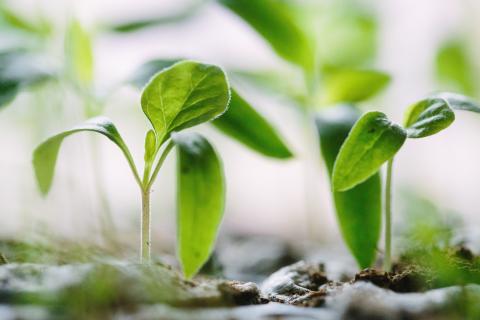Seed Starting Basics

This is the time of year when we gardeners start thinking about our gardens and perhaps starting a few plants inside to get a jump on the season. If you do decide to start some plants inside, there are a few things to consider as you do this which will help you have a greater degree of success with this project.
Seed Selection
It is always best to start with good quality seeds from a reliable supplier. There are many seed companies to choose from, but if you have a choice, purchase seeds from northern growers, as these plants will be better adapted to the climate in New Hampshire. If you saved your own seeds from last year’s crop you can try sowing these as well. However, you may not end up with the plants you expected if the seeds you saved were from a hybrid variety or if they were cross-pollinated. If you have seeds leftover from previous years you can use those as well, but realize that seed viability goes down with each successive year. If you use seeds that are more than a year old, you will need to plant more of them to make up for poor germination.
Starting Media
A good seed starting medium should be fine, uniform, well aerated, and loosely packed. It also needs to be free of insects, disease organisms, and weed seeds. For best results, choose a soil-less seed starting mix composed of peat moss, fine-grade vermiculite or perlite. Reusing old potting soil is not recommended because it may be contaminated with diseases. You can make your own potting medium as follows: 4 quarts of shredded peat moss, 4 quarts of fine-grade vermiculite, and 2 Tbsp. of ground limestone. These mixes have no fertility, so the seedlings need to be watered with a dilute fertilizer as the first true leaves appear.
Water
Seedlings need a steady supply of water and are best watered from the bottom. Do not allow them to become water-logged as this will reduce the oxygen that is available to the plant. So do keep the media moist, but not water-logged.
Light
Certain seeds need light to germinate, and if so, it should be stated on the package. Some seeds, like lettuce, need light in order to germinate, so plant them uncovered or lightly cover them with a sprinkling of seed starting media. Other seeds require darkness to germinate and should be covered. Once your seeds have sprouted, they will need supplemental lighting to prevent them from getting “leggy”. Seedlings that do not get enough light tend to develop long, weak stems as they reach for the light. You can prevent this by providing the necessary light. You can suspend two 40-watt fluorescent lights six to twelve inches above your seedlings for 18 hours a day. If at all possible move them outside for increasing amounts of time when the weather permits so that they can get used to full sunlight.
Temperature
Most seeds germinate between 65-75 degrees F. If the ambient temperature in your home is lower than this, heating mats placed beneath your seedlings can elevate the temperature of the growing medium and encourage germination. Heating mats are almost essential for growing plants like tomatoes which prefer the temperature to be around 80 degrees F. to germinate.
Timing
One of the biggest problems people have with starting seedlings is timing. Starting seeds too early often results in poor quality plants that fail to thrive even when transplanted into the garden. Deciding when to plant your seeds should be based upon when they can safety transplanted outdoors. For much of New Hampshire, it is safe to assume that you can plant your tender flowers and perennials in the garden after Memorial Day. Of course, late frosts are always possible, so pay attention to the forecast before you plant. Use the instructions on the seed packets as a guide for when to start your seeds. It is best to make a chart or use a calendar to keep track of when you need to plant indoors for the optimal time for them to go outside.
Hardening Off
Plants grown from seed need to be acclimated to outdoor conditions before they are planted in the garden. One to two weeks before transplanting, plants should be moved to an area that is 45 to 50 degrees F indoors, or outdoors in a shady location out of the wind. A ventilated cold frame or a shelter covered with a shade cloth will work well for this purpose. Gradually move them into the sunlight for a few hours a day, gradually increasing their exposure. Don’t put new seedlings out on windy days or when the temperature is below 45 degrees F. Reduce watering as the plants as you harden them off, but do not allow them to wilt.
The main advantage of starting seeds inside is that you will be able to try new varieties or unusual plants or herbs that you cannot otherwise buy. Gardening is an adventure that you go on each year. Starting things inside allows you step out into different directions than you have in previous years and go down new and interesting paths.
Learn More In Our Seed Starting Fact Sheet
Do you love learning about stuff like this?
SUBSCRIBE TO GRANITE STATE GARDENING
A monthly newsletter for New Hampshire gardeners, homesteaders and plant-lovers of all kinds, that includes seasonal suggested gardening tips, upcoming events and articles with proven solutions for your garden and landscape.
UNH Cooperative Extension Master Gardener volunteers share information about home, yard, and garden topics with the people of New Hampshire. Got questions? Master Gardeners provide practical help finding answers to your questions through the Ask UNH Extension Infoline. Call toll free at 1-877-398-4769, Monday to Friday, 9 a.m. to 2 p.m., or e-mail us atanswers@unh.edu.
Related Resource(s)

